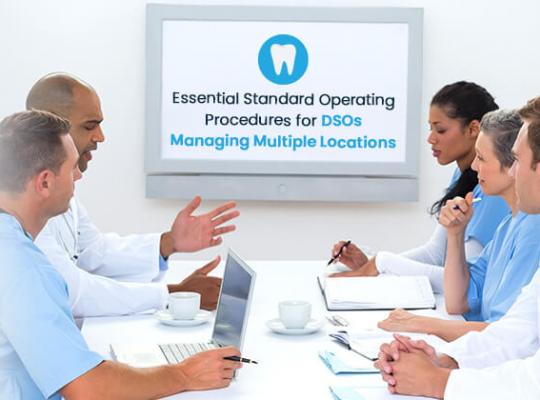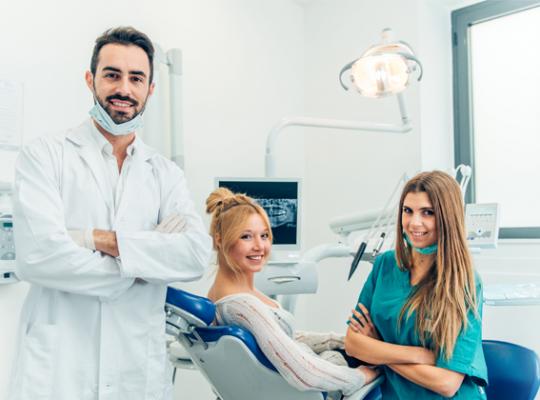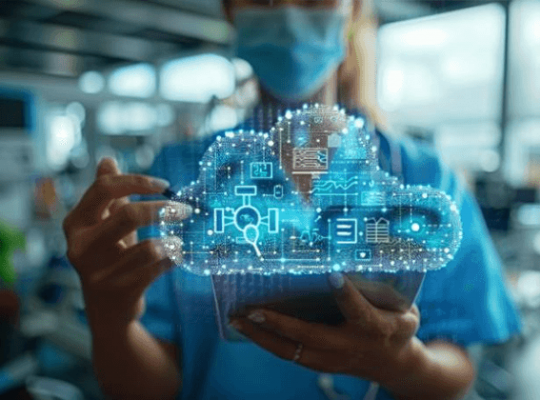Ends in
ends in 127 Days

ends in 127 Days

ends 11 July
From Paper to Digital: Transitioning to Electronic Health Records
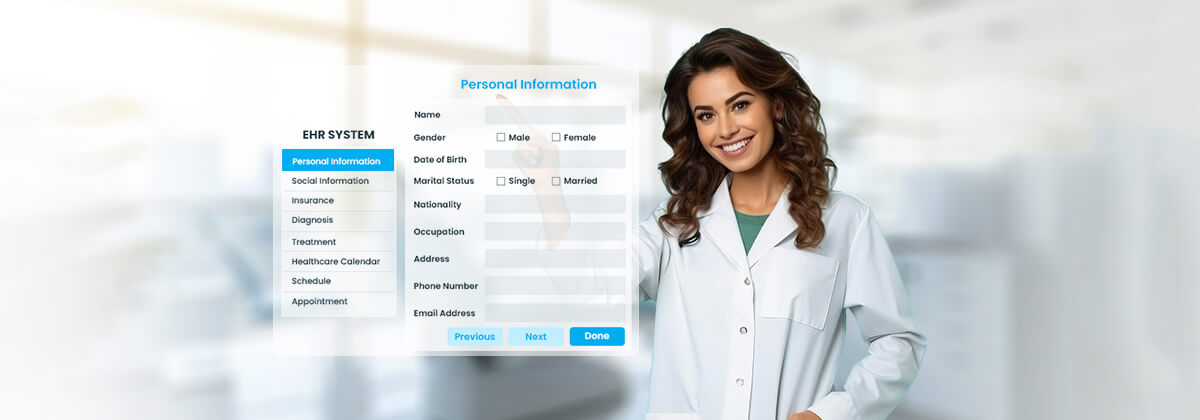
In dentistry, efficiency and accuracy are critical skills. Dental professionals often juggle patient care with administrative duties, which can lead to inefficiencies and errors, particularly when relying on traditional paper-based or disjointed electronic file systems.
Imagine transforming your practice into a streamlined, digital operation where routine tasks are automated, patient visits are more efficient, and more time is devoted to delivering exceptional care. This is the promise of Electronic Health Records (EHR). Transitioning to EHR isn't just about eliminating paper; it's about revolutionizing your practice to enhance efficiency, accuracy, and patient-centric care.
What is EHR?
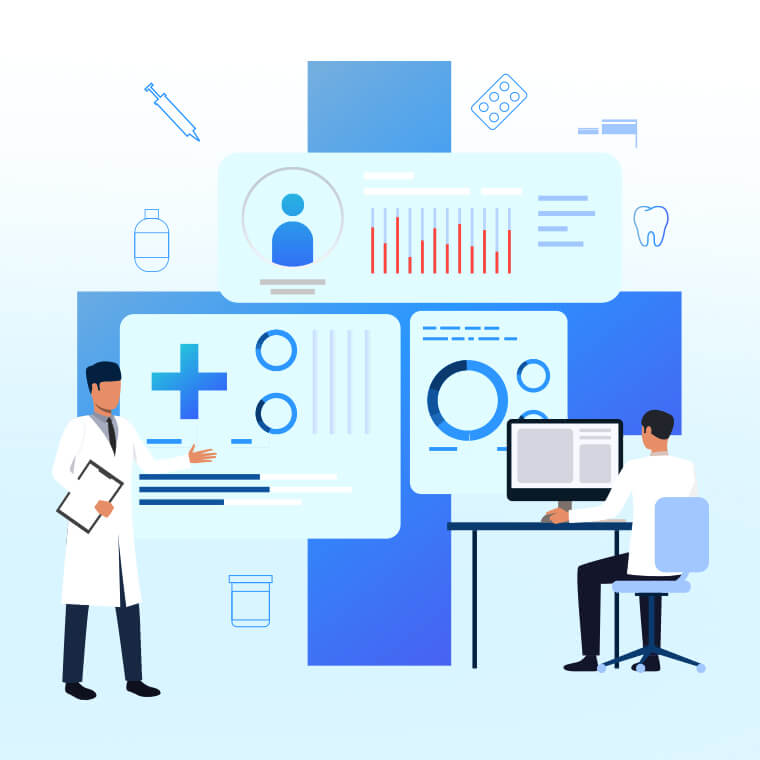
Electronic Health Records (EHR) are digital versions of patients' paper charts. Unlike traditional paper records, EHRs are comprehensive, real-time documents that make patient information instantly accessible to authorized users. They include a patient's complete medical history, diagnoses, medications, treatment plans, immunization dates, allergies, radiology images, and laboratory test results. This technology is a crucial piece to any modern recordkeeping best practice.
EHR Vs. EMR
While EHR and Electronic Medical Records (EMR) are often used interchangeably, there are distinct differences between the two:
EMR: Electronic Medical Records are digital versions of the paper charts found in a single clinician’s office. EMRs include the medical and treatment history of patients within that practice but are limited in that they do not easily travel outside the practice. For example, if a patient needs to see a specialist, their EMR may not be accessible to the specialist, requiring additional paperwork or delays.
EHR: On the other hand, EHRs are shareable with other healthcare providers. They contain information from all clinicians involved in a patient’s care and make information sharing across different healthcare organizations less of a hassle. For instance, if a patient has seen multiple dental specialists, their EHR can provide a comprehensive view of their health history, improving coordination and continuity of care.
Challenges of Traditional and EMR File Systems
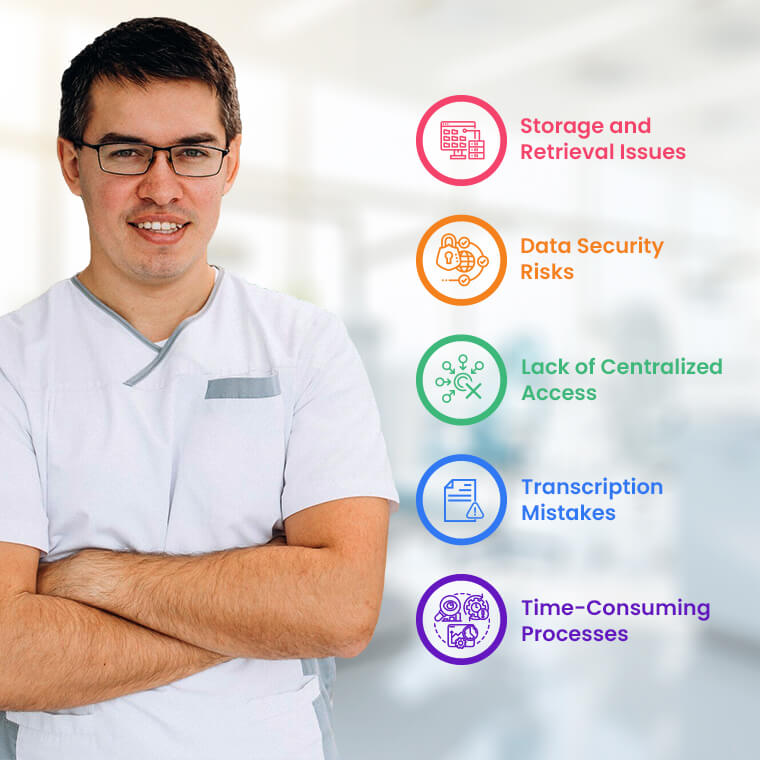
Managing patient records with traditional paper-based systems or even some early EMR systems presents several inherent challenges that can significantly impact the efficiency and quality of care in a dental practice. Understanding these challenges is crucial for recognizing the benefits of transitioning to a more modern, integrated EHR system.
- Storage and Retrieval Issues: Paper files require extensive physical storage space and can be cumbersome to manage. Imagine having to retrieve a patient's records from a filing cabinet during a busy appointment – it can be time-consuming and disrupt workflow. Electronic systems that are not integrated can also suffer from similar inefficiencies if data is scattered across different systems.
- Data Security Risks: Paper records are prone to physical damage, loss, or unauthorized access. Electronic records stored on local systems are vulnerable to data breaches or hardware failures. For instance, a fire in the office could destroy physical records, while a cybersecurity attack could lock you out of your electronic files if not properly secured.
- Lack of Centralized Access: With paper-based or siloed electronic systems, accessing patient information across different locations or by various team members can be challenging. This can lead to inconsistencies in patient care and administrative inefficiencies. For example, if a patient sees multiple specialists within your practice, having disjointed records can result in duplicated tests or missed treatment follow-ups.
- Transcription Mistakes: Handwritten notes are susceptible to errors and can be difficult to read. Mistakes in handwritten prescriptions or treatment plans can lead to significant issues in patient care. EHRs eliminate these problems by providing clear, typed entries that are easy to read and less prone to error.
- Time-Consuming Processes: Manual entry and filing of patient information take valuable time and are hurting the efficiency of your dental office. If your administrative staff spends hours entering data from paper records into a system, that time could be better used to assist with patient care or address other critical tasks.
Revolutionizing Dental Patient Recordkeeping with EHR
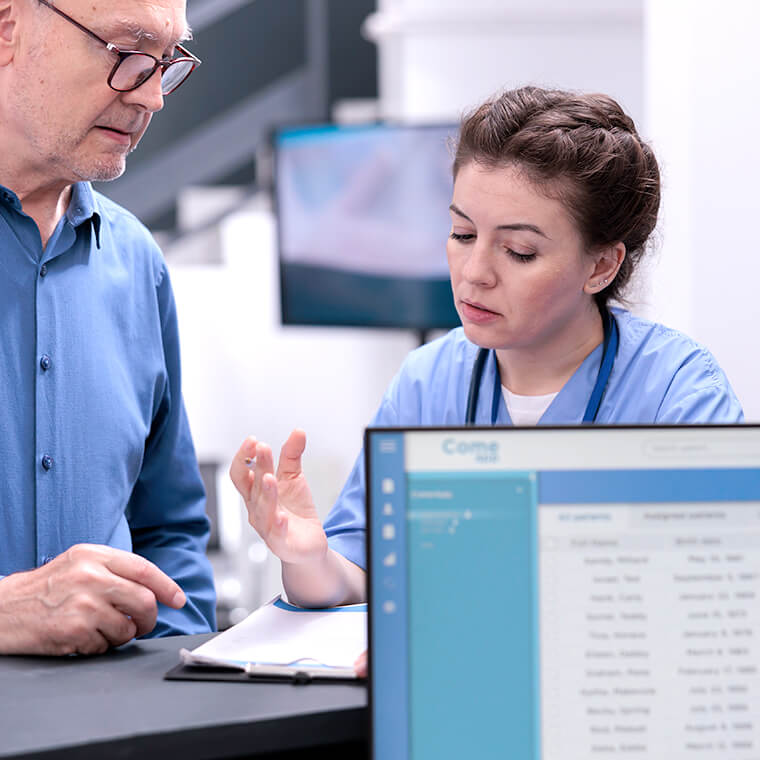
Electronic Health Records have fundamentally transformed healthcare on a global level, especially in how dental providers manage patient information. Unlike traditional paper-based or isolated EMR systems, EHRs provide a comprehensive and integrated approach to recordkeeping that enhances accuracy, accessibility, and efficiency.
Seamless Integration with Modern Dental Software
EHR systems are designed to work seamlessly with dental software systems, creating a cohesive and efficient practice management ecosystem. This integration allows EHRs to connect with various tools such as digital imaging systems, billing software, and patient communication platforms. For instance, an EHR integrated with digital radiography can automatically attach imaging results to a patient’s record, ensuring that all relevant information is in one place.
Additionally, integration with dental billing and insurance systems can streamline claim processing and payment tracking. By linking EHRs with these complementary technologies, your dental office can further enhance its operational efficiency and provide a more connected, streamlined experience for both staff and patients.
Easy Access Anytime, Anywhere
EHRs greatly improve the accessibility of patient records. Unlike paper records, which are confined to the office where they are stored, patient data is available from any location with internet access. This centralized access allows dental professionals to retrieve and update patient information quickly and efficiently, whether they're at the office, on a home visit, or even on vacation. For example, if a dentist needs to review a patient's history while attending a conference, they can log into the EHR system remotely, ensuring they have the most up-to-date information at their fingertips. This flexibility enhances the ability to provide timely and informed care, regardless of where your dentists are located.
Better Accuracy and Readability
One of the biggest advantages of EHR systems is the elimination of issues related to illegible handwriting and transcription errors. Paper records often suffer from unclear notes and manual entry mistakes that can lead to misunderstandings or incorrect treatments.
Vacek Family Dentistry: Streamlining operations and boosting case acceptance with Adit 5-star care starts with the right tools. From smart financing to powerful analytics, this Nebraska practice found the formula for happier patients...
Schedule a DemoEHRs replace these problems with a digital format where information is typed directly into the system, ensuring clarity and consistency. This means that every team member involved in a patient's care, from dentists to hygienists to administrative staff, has access to accurate and easily readable records. For instance, a treatment plan entered into the EHR is clear and unambiguous, minimizing the risk of errors and ensuring that everyone is on the same page regarding the patient's care.
Complete Patient History
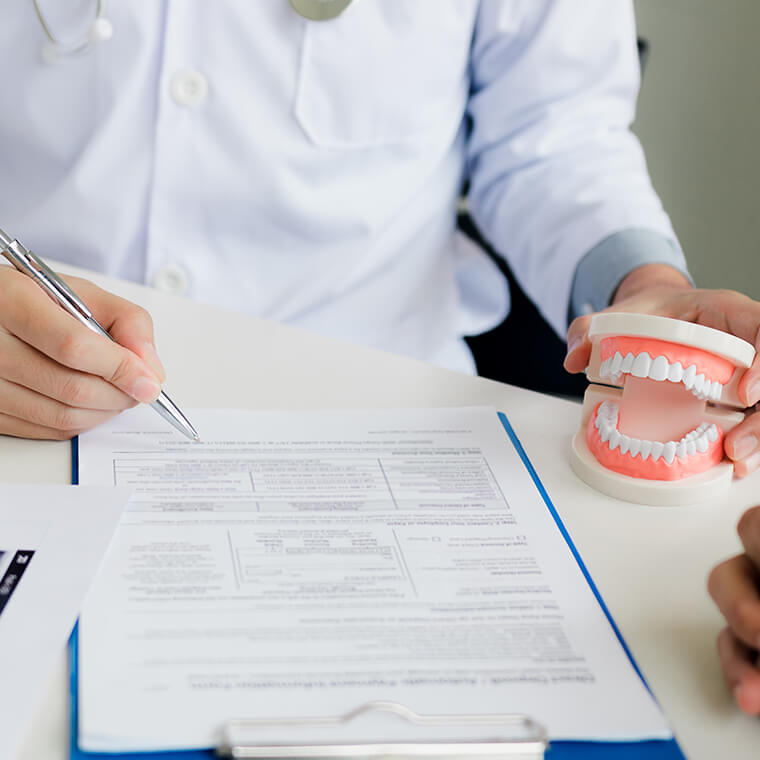
EHRs provide a comprehensive and organized view of each patient's medical history, including detailed treatment plans, progress notes, and past medical histories. This complete record is invaluable for making well-informed decisions about a patient's care.
For example, if a patient returns with a recurring issue, the dentist can easily access the EHR to review the patient's full treatment history. This detailed overview can help identify patterns, track the progression of issues, and determine if previous treatments were effective or if new approaches are needed. Having all this information in one place allows for better diagnosis and more tailored treatment planning.
Strong Data Security
Data security and privacy are paramount in healthcare, and EHR systems are designed with robust security measures to protect patient information. Modern dental record systems use advanced encryption techniques to safeguard data, ensuring that sensitive information remains confidential and secure.
Access controls are in place to restrict who can view or modify records, adhering to regulations such as HIPAA (Health Insurance Portability and Accountability Act). This means that only authorized personnel can access patient data, reducing the risk of unauthorized access or data breaches. The emphasis on data security helps maintain patient trust and ensures that their personal information is handled with the utmost care.
Streamlined Administrative Tasks
EHR systems also simplify and streamline a range of administrative tasks and processes. They can automate processes such as appointment scheduling, billing, and insurance claims, reducing the administrative burden on staff.
For example, an integrated EHR system can automatically schedule appointments, send reminders to patients, and handle insurance claims with minimal manual intervention. This automation not only saves time but also reduces the likelihood of errors associated with manual entry. By easing the administrative workload, EHRs allow staff to focus more on patient care and improve overall office efficiency.
EHR and Dental Practice Management Software
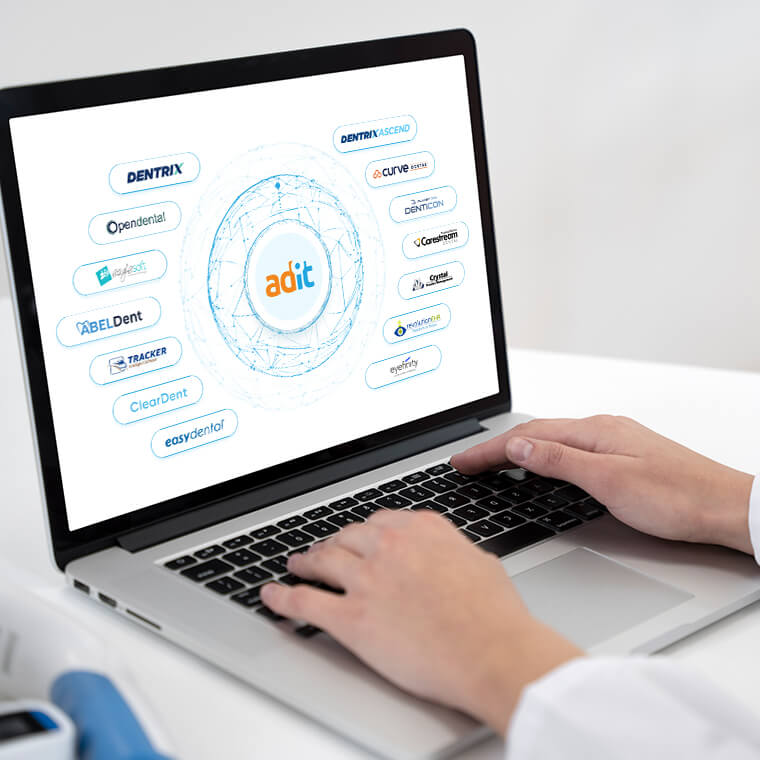
Integrating Electronic Health Records (EHR) with dental practice management software represents a significant leap forward in optimizing practice operations. This integration goes beyond merely digitizing patient records; it involves a seamless connection between clinical data and administrative functions.
Automated Updates
One of the significant advantages of integrating EHR with practice management software is the automation of updates. Instead of manually entering patient information into different systems, the software does it automatically. When a patient form is completed and submitted electronically, such as updating their medical history or personal details, the information is immediately reflected in the EHR. This reduces the risk of errors associated with manual data entry and ensures that all patient records are current and accurate.
Insurance Pre-Verification and Claim Processing
Integrating EHR with practice management software also streamlines the insurance process. The software can automatically verify patient insurance coverage before their appointment, reducing the need for manual checks and helping to prevent billing issues. Plus, claim processing is expedited as the system can submit claims electronically and track their status in real-time. This integration minimizes delays caused by manual errors and ensures that claims are processed accurately and efficiently.
Centralized Patient Records Management
With a centralized system, all patient information—such as medical histories, treatment plans, and billing details—is stored in one place. This centralization simplifies access for authorized staff and improves the coordination of care creating a more personalized treatment planning experience. Additionally, centralized records reduce the chances of information being lost or overlooked, leading to better patient outcomes.
Efficiency Gains and Time Savings

Automation of routine tasks significantly boosts efficiency, saves time, and offers a host of additional benefits that are too many to list in one sentence. Tasks such as appointment scheduling, sending reminders, and managing follow-ups can be handled automatically by the software. Automating these routine processes reduces the administrative burden on staff, allowing them to focus more on patient care and other high-priority tasks.
For instance, automated appointment reminders can decrease the number of missed appointments, ensuring that patients adhere to their treatment schedules and that practice time is used effectively. By handling routine tasks efficiently, the practice can operate more smoothly and provide better patient service.
Enhanced Patient Communication
Effective communication is crucial for patient engagement and satisfaction, and practice management software often includes features to enhance this. Consider how this software can send automatic appointment reminders, follow-up messages, and educational materials related to treatment via email, SMS, or through your dental website. These features help keep patients informed and engaged with their care.
A patient might receive a reminder email about an upcoming appointment, along with useful information on what to expect during their visit. This proactive communication not only helps patients stay on track with their appointments but also educates them about their treatment, leading to a more informed and satisfied patient base.
8 Tips to Eliminate Outdated Patient Record Processes

Transitioning from an outdated records system to EHR involves more than just implementing new technology; it requires a strategic approach to fully embrace the digital transformation. Here are some additional tips to help you successfully lose the paper and make the most of your new EHR system:
1. Conduct a Thorough Audit
Before you switch to a new system, start by reviewing all your current paper and electronic records. Figure out what needs to be moved to the new system, what can be archived, and what should be discarded. For example, if you have outdated patient records that aren't relevant anymore, you can either archive them or dispose of them according to legal guidelines. This process will help you streamline the transition and keep your digital records organized right from the start.
2. Invest in Training and Support
Proper training is key to making the switch to an electronic health record system smoothly. Make sure everyone in your practice, from front-office staff to clinicians, gets comprehensive dental software training on how to use the new system. You might start with hands-on training sessions to help staff get familiar with the EHR's interface and features. Also, consider providing additional resources like online tutorials, user manuals, and support from your dental practice management system provider to address any questions or issues that come up.
3. Digitize Existing Records Gradually
Rather than trying to digitize all your paper records at once, take a gradual approach. Start by converting the most recent and frequently accessed records to digital format. For instance, focus on records for active patients and those with ongoing treatments first. As your team becomes more comfortable with the new system, you can gradually move on to older records. This way, you avoid overwhelming your staff and ensure a smooth transition with minimal disruption to patient care.
4. Establish Clear Data Entry Protocols
To keep your records consistent and accurate, set clear data entry protocols for your EHR system. Create standard procedures for entering patient information, updating records, and handling data entry errors. Consider developing a checklist for data entry that includes verifying patient details, recording treatment information, and updating medical histories. Consistent protocols help maintain the accuracy of your digital records and reduce errors.
5. Ensure Seamless Integration with Other Systems

Make sure your EHR system integrates smoothly with other practice management tools to enhance efficiency. For example, link your patient records system with online scheduling software to automatically update patient records with appointment information. Integrate your billing systems to streamline claims processing and cut down on manual data entry. Seamless integration helps create a cohesive digital environment and boosts overall practice efficiency.
6. Communicate with Patients
Let your patients know about the transition to EHR and how it will benefit them. For example, you could inform patients via email or during their appointments about the new system and its advantages. Explain that their records will be more accessible and secure, and highlight features like online patient access where they can manage appointments and see their dental care information.
7. Monitor and Evaluate the Transition
Regularly check in on the transition process to spot any issues and find areas for improvement. For example, keep track of metrics like how quickly records are retrieved, the accuracy of data entry, and feedback from staff. Conduct periodic reviews to make sure the EHR system is meeting your practice's needs and make any necessary adjustments.
8. Promote a Paperless Culture
Encourage a paperless dental office by highlighting the benefits of digital recordkeeping. Make an effort to recognize dental team members who actively help reduce paper use or suggest improvements to digital processes. Creating an environment that embraces technology and innovation ensures a smooth and successful transition to EHR.
Streamline Your EHR Transition with Adit

Transitioning from paper to digital with EHR and integrated practice management tools is a vital step in modernizing your dental practice. Adit Dental Software is at the forefront of innovation, dedicated to providing cutting-edge solutions tailored specifically for dental professionals. Our software is designed with the busy dental office in mind, aiming to streamline workflows and enhance treatment planning through a suite of integrative practice tools.
Adit Dental Software is a pioneering solution that combines expertise in dental practice management with powerful EHR capabilities. Our tools are crafted to meet the demands of busy dental professionals, offering a comprehensive range of features designed to optimize every aspect of your practice:
- Telemed: Conduct virtual consultations and follow-up appointments effortlessly, bringing dental care directly to your patients.
- Patient Recall: Automated follow-up campaigns keep patients engaged and ensure they attend their virtual and in-office appointments.
- Pozative Reviews: Manage patient feedback and enhance your practice’s reputation with our review management tools.
- Adit Pay: Streamline billing and payment processing for both virtual and in-office visits.
- Practice Analytics: Gain insights into performance with detailed analytics, helping you optimize your telehealth services.
- Online Scheduling: Allow patients to easily book virtual and in-office appointments that fit their schedules.
- CareCredit Integration: Simplify financing options for your patients, making it easier for them to access care.
- Adit Voice: Improve communication with integrated VoIP for secure calls and texts.
- Patient Forms: Use digital patient forms to streamline intake and consent processes.
- Reminders: Automated notifications for appointments and follow-ups to reduce no-shows.
- Patient Text: Engage patients with secure text messaging for quick updates and consultations.
- Internal Chat: Enable real-time communication among your team to coordinate care more effectively.
- Treatment Planning: Share detailed treatment plans digitally during virtual consultations.
- Dental Digital Marketing: Promote your teledentistry services and attract new patients through targeted marketing campaigns.
- Call Tracking: Monitor and analyze patient calls to enhance service and follow-up.
- Website Design: Upgrade your online presence with a professional website showcasing your telehealth services.
Book a Free Demo
Discover how Adit Dental Software can transform your practice by enhancing efficiency and improving patient care. Schedule a free demo today to experience our innovative dental management solutions firsthand and see how our comprehensive suite of tools can support the growth and success of your practice.
more about Adit?
Access a full suite of patient communication tools with Adit! Texting, payments, reviews, & scheduling in one place.
Schedule a DemoJosh has made a career working with large DSO organizations and leveraging his extensive sales experience to build partnerships with influential doctors and organizations within the dental industry. He travels the US as an expert guest speaker in medical seminars teaching doctors how to streamline their practices with the latest technology.
Get a $25 Gift Card when you take a demo
Schedule a Demo
Get a $50 Gift Card
when you take a demo
Looks like you're out of bounds!
Hey there! Your current location falls outside Adit's area of operation. If this is unexpected, try disabling your VPN and refresh your page. For further assistance or to book a live demo, connect with us at 832-225-8865.
January 7 Amazon Demo Promo
Terms and Conditions
Last Updated: January 7, 2026Offer ends January 10, 2026, and is limited to prospective customers who sign an annual agreement before January 31, 2026. Gift card will be emailed to the company owner or established representative within 4 weeks of signing the annual agreement. Offer may not be combined with any other offers and is limited to one (1) gift card per office. Offer is not available to current customers or to prospective customers or individuals that have participated in a Adit demo during the prior six (6) months. Recipient is responsible for all taxes and fees associated with receipt and/or use of the gift card as well as reporting the receipt of the gift card as required under applicable federal and state laws. Adit is not responsible for and will not replace the gift card if it is lost or damaged, is not used within any applicable timeframe, or is misused by the recipient. Adit is not responsible for any injury or damage to persons or property which may be caused, directly or indirectly, in whole or in part, from the recipient’s participation in the promotion or receipt or use of the gift card. Recipient agrees to indemnify, defend and hold harmless Adit from and against any and all claims, expenses, and liabilities (including reasonable attorney’s fees) arising out of or relating to a recipient’s participation in the promotion and/or recipient’s acceptance, use or misuse of the gift card. This offer is sponsored by Adit Communications, Inc. and is in no way sponsored, endorsed or administered by, or associated with Amazon.
Thank You!
We appreciate your interest! Adit AI will be calling you in the next few minutes!
Why Adit?
Cut your software bill by up to 60% when you merge everything your dental office needs to run under one roof.
Centralize Communications
- Phones & TeleMed
- Emails & eFax
- Texting & Reminders
- Call Tracking and more!
Streamline Operations
- Patient Forms
- Online Scheduling
- Payments
- Reviews and more!
Boost Production
- Performance Dashboards
- Morning Huddle
- Claims & Collections
- Patient Profiles
- Follow Up Lists
- Year Over Year Metrics
Acquire More Patients
- Digital Marketing
- Website Design
- SEO
- Google Ads
- Facebook Ads
Ends in
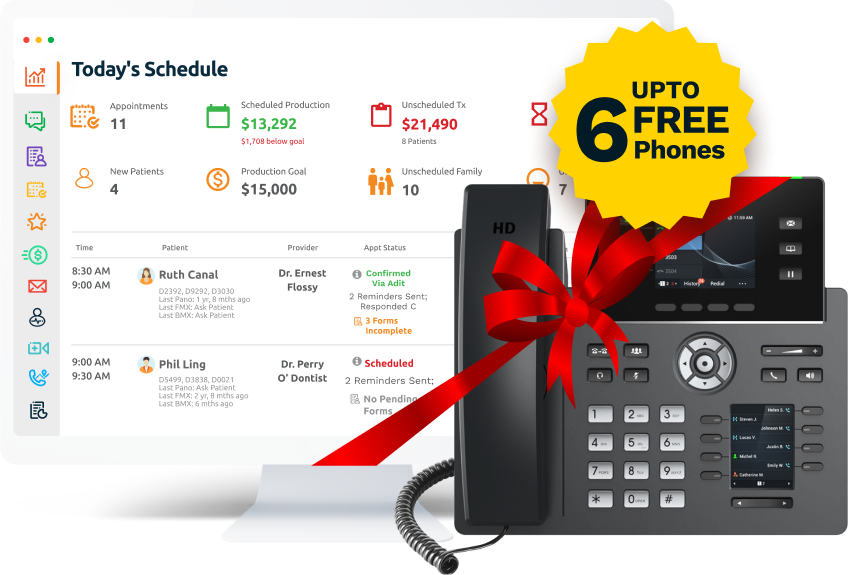
and Get Free Phones for Life
Sign up by filling out the form


